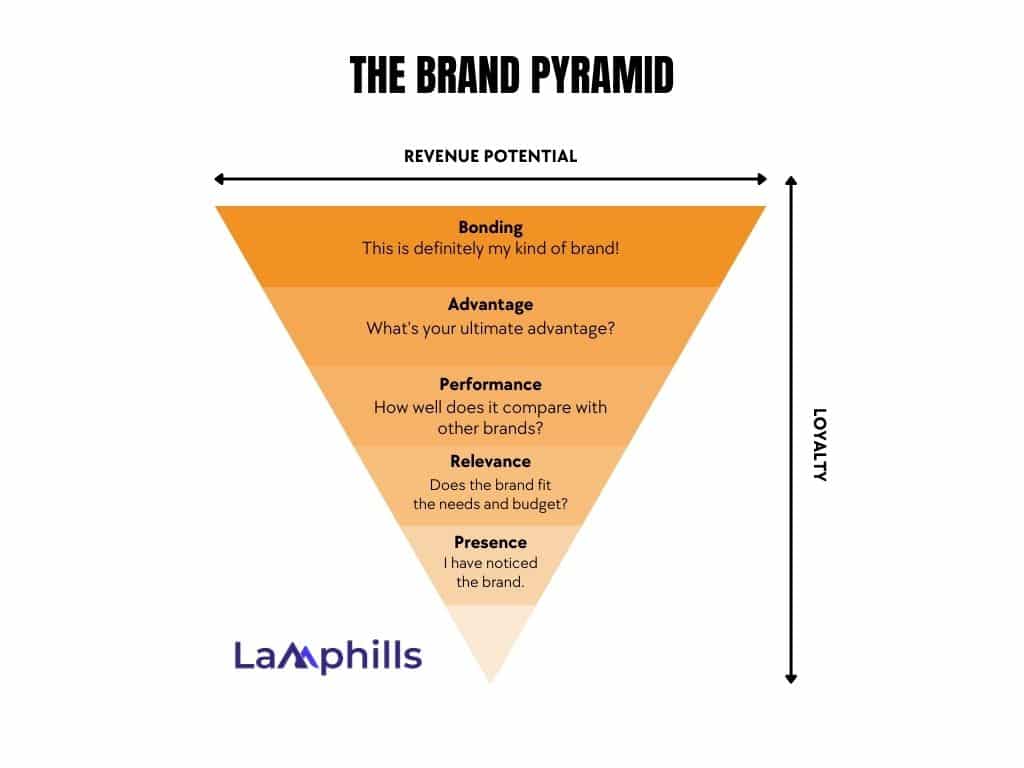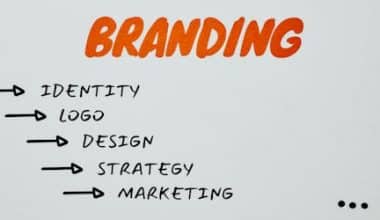It’s one thing to love a brand because it suits a functional need and it’s another thing to love a brand simply because you developed a strong positive emotion towards them. No matter how you look at it, a customer who follows a brand based on emotions is more loyal than one who follows because of what they are getting in return. But how does a customer develop this inseparable feeling? How do you know how your customers feel about your brand? How can marketers and strategists who want to boost customer loyalty use this to their advantage? That’s where “Brand Pyramid”.
In this guide, I will carefully explain how you can use the Brand Pyramid tool to your advantage and also provide templates and examples that will help you increase your customers’ loyalty to your brand. Let’s get into detail.
Key Points
- The Brand Pyramid organizes your brand’s core aspects—purpose, values, benefits, reasons-to-believe, and personality—creating a clear identity.
- Storytelling connects emotionally with audiences, turning brand facts into memorable narratives.
- Each Brand Pyramid level guides storytelling, ensuring it aligns with brand identity and purpose.
- The Brand Pyramid Storytelling Guide Template helps structure your brand story, translating core values into a cohesive narrative.
- Consistent storytelling builds brand recognition and loyalty, leaving a lasting impression on your audience.
What is a Brand Pyramid?
In simple terms, one can say that a brand pyramid is a marketing tool that can assist anyone in addressing significant concerns about your company’s services and effectively defining them for customers. Starting with the fundamental qualities of a product, brands can work their way up the brand pyramid to more explicitly articulate core values and message goals. This notion works equally well for digital and traditional marketing methods.
When constructing a brand pyramid, begin by describing a product’s fundamental features, then progress to how these features benefit customers. Next, examine how you want your customers to react emotionally to your products and brand image. Only then will you be able to create your brand persona and convey the core of your brand identity.
All these processes are then likened to what will make a target audience develop a feeling for the brand in question, and before you know it, they develop loyalty, buy your products and services, and speak of your goodness to other target audiences. Interesting right? I know.
Now that we’ve broken down each level of the Brand Pyramid, it’s time to put theory into action. Storytelling is essential to building a memorable brand that resonates with your audience. To help you craft stories that align with your brand’s core, I’ve created a Free Brand Pyramid Storytelling Guide Template:
Brand Pyramid Storytelling Guide Template.PDF
Who Created the Brand Pyramid?
Millward Brown (now known as Kantar), a marketing research firm, established the brand pyramid in the 1990s. This whole setup and discovery all started with 30 years of brand study and thousands of data sets, and in turn, served as the foundation for today’s brand pyramids.
Later on, Kevin Lane Keller created Keller’s Brand Equity Model, often known as the customer-based brand equity model. This pyramid depicts customer relationships with your brand and provides a bottom-up view of customer-to-company relationships.
And from there, these two pyramids grew into the brand pyramids we know today. The brand equity pyramid served as the foundation for the external brand sharing type, whereas the Keller Model evolved into today’s internal brand loyalty pyramid.
What are the Benefits of Brand Pyramid?
A brand pyramid has a whole bunch of benefits that are tailored to help an organization in a variety of ways. For starters, brand pyramids are visual tools that rapidly communicate your brand’s identity and help you make a good first impression. And with this, it can be an effective way to disseminate information about your brand’s unique characteristics.
Successful branding makes the difference between a decades-old firm and a flop, and if you’re not consistent and noteworthy, you won’t last long. Let’s look at some of the advantages of having a brand pyramid:
#1. Coherent Core Identity
A brand pyramid can help you build and promote your company’s essential identity. It can answer simple questions asked by potential clients and reinforce the positive views of existing customers.
#2. Consumer Confidence
It can also be a valuable tool for ensuring that your branding is consistent across all platforms. A consistent brand message creates a trustworthy brand that customers are more likely to return to in the future. Ideally, people will know you right away and recall their initial impressions.
When they see that your brand has been truthful since its emergence, it will trigger a strong positive emotional reaction, which can be used to gain loyalty and boost word-of-mouth advertising.
#3. Effective Communication

A brand pyramid is a visual tool that instantly communicates your brand’s key principles and identity. It will speak for itself without having to stress for anything.
#4. Appealing Brand Personality
Successful branding humanizes your brand and makes it more accessible. A brand pyramid ensures that you have a personality that stands out from the crowd and other businesses in your niche. So it’s very important that you humanize your brand and be consistent with it cause a customer is more likely to come back to a brand they feel is friendly.
#5. Easy to use
A brand pyramid can be thought of as a reduced form of your brand style guide, which is easier to transmit, share, read, and present. And with that in place, anything you share will generate optimistic curiosity because you’re already a trusted brand.
#6. Emotional Response
A brand pyramid is designed to provoke an emotional response from your customers by indicating how they should feel about your brand. Communicating that your brand is enjoyable, professional, and trustworthy will help them have a fantastic experience. So, while at this, ensure that you stay consistent on whatever standards you have set up at first.
#7. Increased Revenue

It maintains consistent branding, raises a brand’s likeability, and, in turn, attracts revenue for your business. Customers will pay more for goods and services when they have built a strong relationship and bond with your brand. So it’s a win-win, whichever way you look at it.
#8. Quality Talent
A brand pyramid draws both customers and staff. With consistent, smart branding, you’ll attract higher-quality individuals who want to join your team and work together to build a more stable business.
Overall, developing a great brand and sticking to it, as long as you correctly interpret your purpose and value statement, will only help your business prosper in the long term. I mean, there are no two ways to do it.
Types of Brand Pyramids
Internal brand pyramids assess customer involvement and purchase loyalty, whereas exterior brand pyramids define a brand’s public image.
#1. Internal Brand Pyramid: These are models used to determine customer purchase loyalty. The bottom of this pyramid indicates customers who have little involvement or emotional investment in your brand, whilst the top shows customers who have a high level of brand loyalty.
These structures are also known as brand engagement pyramids, brand dynamics pyramids, or brand loyalty pyramids.
#2. External Brand Pyramid: This covers methods for simply communicating your brand’s identity to the outside world. These pyramids help firms identify and visually display their brand identity.
There are also a lot of related names these pyramids can also be identified with, and they include brand equity pyramids, brand positioning pyramids, brand DNA pyramids, brand building pyramids, brand essence pyramids, brand identity pyramids, brand resonance pyramids, brand equity pyramids, brand DNA pyramids, brand building pyramids, brand essence pyramids, or brand identity pyramids.
What are the Five Layers of the Brand Pyramid?
The Brand Pyramid consists of the five key stages that customers go through as they build a relationship with a brand, beginning with basic awareness and ending with complete loyalty. Just as simple as it sounds, nothing too complicated.
Your goal is to move as many consumers as possible up the pyramid. After all, the further up the pyramid someone is, the more likely they are to spend money with your company. This explains why the pyramid is inverted. You understand?
Now, let’s look at the five levels of the Brand Pyramid in greater detail:

Level 1: Presence
Just like in the chart above, your brand presence has been noticed. Customers at this level are familiar with your brand, but they do not know so much. They may have used your products and services previously, but they have little or no emotional attachment to them. So you need to keep working your way up.
Level 2: Relevance
At this stage, clients begin to consider whether your brand satisfies their goals, needs and budget. They begin to weigh the expense of your product against the value it offers.
They might begin asking themselves things such as: “Does this brand fit my needs?” “Is it in the right price bracket for me?” “Is it worth it?”
Level 3: Performance
At this level, customers begin comparing your brand to others to determine whether it meets their needs and provides the value they desire. They are also starting to identify your brand with a specific identity and recognize it more frequently.
By now, your product or service is on the customer’s “short list” of brands to consider. And also at this stage, they start to compare your brand with your competitors or other brands. So you need to tighten up your game.
Level 4: Advantage
At this point, customers have established that utilizing your brand has a distinct advantage over competitors. They also start to correspond with their own feelings and identities.
Level 5: Bonding
This is the last stage, and here, customers have formed a deep affinity with your brand. They’ve established that your brand’s cost, benefits, and performance all satisfy their standards.
They’ve developed a strong emotional attachment to it. Your brand has become an essential element of their self-image, helping to define who they are. As a result, people prefer your brand over others.
Customers at this level are also likely to be vocal supporters of your brand, aggressively promoting it in their family, social, and professional networks.
How to Build a Brand Pyramid?
Since you have fully understood what it means to explore a good brand pyramid in your business, you might as well be interested in learning how to build one that is effective and useful to you. Let’s quickly take a look at some steps that will ensure you build one that drives significant impact within your business:
#1. Analyze Your Current Branding Approach
The very first step to try out here is to detect if your existing strategy is producing the expected results and reaching the intended audience. Then go ahead to compare your current clients to those you intend to recruit, and explain which branding objectives you have and have not fulfilled.
To make sure this step is perfected, ask yourself: Is your brand aiding you in meeting your company goals, impeding them, or accomplishing something unexpected? Is it geared toward the people you wish to reach? When you can comfortably answer these then you are a step ahead.
#2. Decide Which Qualities to Emphasize
Next, establish a list of your brand’s distinguishing traits and decide which ones to stress. Let’s say, you might want clients to recognize your brand as a reliable and effective one, a creative problem solution, or a helpful source of knowledge. When you define what you want, then go ahead and promote it.
Depending on your industry, you may want to highlight the quality of your product, the convenience of your services, or the friendliness of your employees.
#3. Create Your Pyramid
When you’re ready, you can begin at any level of the pyramid and move in the direction that makes sense to you. No pressure because it will only make
#4. Design Your Pyramid
Next, work your brand guidelines into the visual style of your pyramid. Be attentive of colors, fonts, and tone of voice. Remember that for a brand pyramid to be effective, it must be simple to read and comprehend.
#5. Make It Shareable
In this last step, you need to make your brand pyramid shareable. You can try uploading your pyramid as a file to your website. Include it in your brand style guide, as well as printed pieces containing your brand story for education and onboarding.
Remember, this document can also function as a cornerstone in your employee onboarding process to ensure new workers fully understand the right methods to convey the brand and also understand how the brand works.
What is a Personal Brand Pyramid?
A personal brand pyramid is a triangle concept that can help you define and explain your value proposition.
The topics on the pyramid increase in difficulty and potential reward as they progress from bottom to top. The pyramid’s vertices reflect relationships, and the foundational elements for personal branding include competence, commitment, personality, differentiators, interest, and soft skills.
Conclusion
To summarize, a brand pyramid may be an extremely effective visual tool for communicating your business’s identity and market positioning. Creating one enables your team, regardless of size, to more effectively convey your core identity, including your brand personality and the benefits you offer to your target customer.
While getting started may appear to be a time-consuming procedure, we can assure you that it will be well worth it! Remember to reach out to us in the comment section if you encounter any difficulty.
Related Articles
- Brand Awareness Campaign Examples: 10 Effective Examples (+ Tips)
- Top 15 Strategies to Increase Your Brand Awareness
- TOP 10 BRANDS OF PERFUMES FOR MEN: Essential Picks
- How to Define and Set Digital Marketing Objectives for Your Brand(+Examples)






